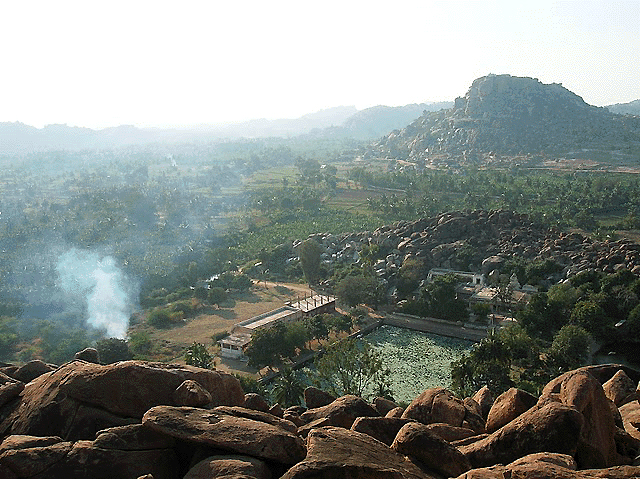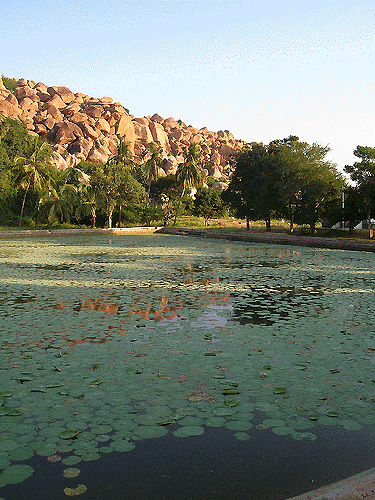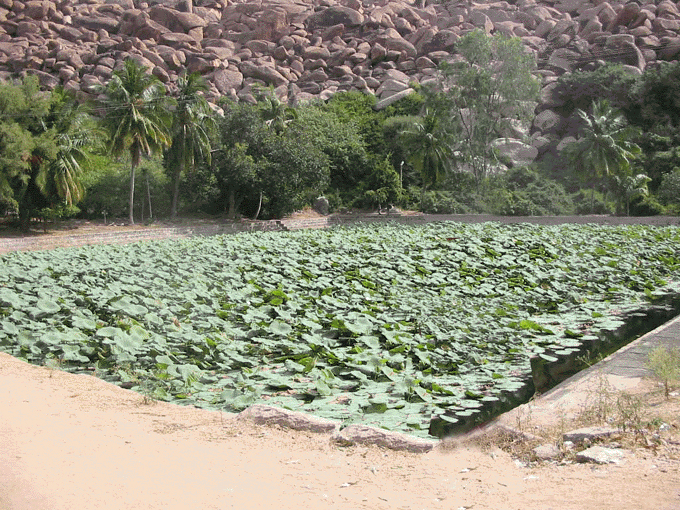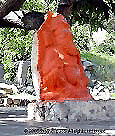
|
|
|
|
BY: SUN STAFF

Pampa Sarovar from Durga Forest Feb 13, CANADA (SUN) — A serial exploration of the holy sites visited by Lord Caitanya. Pampa-sarovara
In the summary of Sri Caitanya-caritamrta Madhya Lila 9 we read about Lord Caitanya's travels to a South India tirtha known as Pampa-sarovara, or Pampa Lake:
Madhya 9 Summary: "The Lord then visited Tapti, Mahismati-pura, Narmada-tira and Rsyamuka-parvata. He entered Dandakaranya and liberated the seven palm trees. From there He visited a place known as Pampa-sarovara and visited Pancavati, Nasika, Brahmagiri and also the source of the Godavari River, Kusavarta. Thus the Lord visited almost all the holy places in South India. He finally returned to Jagannatha Puri by taking the same route, after visiting Vidyanagara again." Later, in his purport to Madhya Lila 9.316, Srila Prabhupada makes it particularly clear in the case of this tirtha that there is considerable difference of opinion as to where Pampa-sarovara is actually located: Madhya 9.316
"Eventually Sri Caitanya Mahaprabhu arrived at a lake known as Pampa, where He took His bath. He then went to a place called Pancavati, where He rested. PURPORT Elsewhere, in Srimad Bhagavatam 7th Canto, Pampa Lake is again named, as one of the many sacred places that devotees should go on pilgrimage to visit. What is interesting about this Bhagavatam verse is how it relates to the question of Pampa-sarovar's precise location. Srila Prabhupada makes the point that all such tirthas – including ISKCON centers around the world where the Deities are being worshipped – should be visited by the devotees. This is the very embodiment of Lord Caitanya's mood, when he traveled all over India spreading His Sankirtana movement.

Pampa-sarovar, Hampi Srimad Bhagavatam 7.14.30-33
"The sacred lakes like Puskara and places where saintly persons live, like Kuruksetra, Gaya, Prayaga, Pulahasrama, Naimisaranya, the banks of the Phalgu River, Setubandha, Prabhasa, Dvaraka, Varanasi, Mathura, Pampa, Bindu-sarovara, Badarikasrama [Narayanasrama], the places where the Nanda River flows, the places where Lord Ramacandra and mother Sita took shelter, such as Citrakuta, and also the hilly tracts of land known as Mahendra and Malaya -- all of these are to be considered most pious and sacred. Similarly, places outside India where there are centers of the Krsna consciousness movement and where Radha-Krsna Deities are worshiped must all be visited and worshiped by those who want to be spiritually advanced. One who intends to advance in spiritual life may visit all these places and perform ritualistic ceremonies to get results a thousand times better than the results of the same activities performed in any other place. PURPORT Sri Caitanya Mahaprabhu wanted the Hare Krsna movement, with installed Deities, to spread to every village and town in the world, so that everyone in the world might take advantage of this movement and become all-auspicious in spiritual life. Without spiritual life, nothing is auspicious. Moghasa mogha-karmano mogha jnana vicetasah (Bg. 9.12). No one can become successful in fruitive activities or speculative knowledge without being Krsna conscious. As recommended in the sastras, everyone should be very eagerly interested in taking part in the Krsna consciousness movement and understanding the value of spiritual life."

Pampa-sarovar, Hampi Balarama and Nityananda's Travels As with so many other tirtha's Caitanya Mahaprabhu visited, Lord Balarama and Nityananda Prabhu also visited Pampa-sarovar. Balarama's travels are narrated in Srimad-Bhagavatam: Srimad-Bhagavatam 10.79.12-13 "Then he saw and praised Parashurama at Mahendra Hill. Having bathed in the seven-fold Godavari, the Vena and Bhimarathi rivers, and the Pampa Lake, Balarama visited Skanda, and then went to Shrisaila, the residence of Girisa (Shiva). From there, the Lord visited Venkatadri, very sacred among the lands of South India." Nityananda Prabhu's travels are likewise narrated in the Nityananda Charitamrta, Adi-Khanda, Chapter 2: Lord Nityananda's Traveling To the Holy Places "Lord Nityananda next took bath in the Gomati, Gandaki, and Sona Rivers. He also climbed the top of Mahendra Mountain. There He offered obeisances to Lord Parasurama. He also visited Haridvara, the source of the Ganges. The Lord took bath in Pampa, Bhimarathi, Venva, and Vipasa Rivers." And in Vrindavana Dasa Thakur's Sri Chaitanya Bhagavat, Adi Lila Chapter 9: "Thereafter Sri Nityananda went to Gomati and bathed in the waters of Gandaki and Sona. He climbed the Mahendra Hill where He offered obeisances to Lord Parasurama. From there He travelled to Haridvara, the source of Mother Ganga. He visited Pampa, Bhima, Godavari, Benva and in the Bipasa (or Vyasa) river He remained submerged in the water for a while." Pampa-sarovar at Hampi In modern times, Pampa Sarovar is generally agreed to be the lake located in the Koppal district of Karnataka, near Hampi. Situated to the south of the Tungabhadra River, it is said to be the place where Pampa, a form of Shiva's consort Parvati, performed penance to express her devotion to Shiva. Pampa-sarovar is also mentioned in Ramayana, and is the place where the well known pastime of Rama's great devotee Shabhari took place. This Pampa Sarovar lake is located in a sheltered valley on the road to Anegundi, from Hospet, about a kilometer from the hilltop Hanuman Temple. Pampa Lake is recognizable today due to the beautiful and thickly growing lotuses that fill the theertha. There are temples of Laksmi and Shiva nearby, and a Ganesh murti, brightly painted in vermilion, is installed beneath a mango tree on the main temple property.

Vinyaka (Ganesh) at Pampa-sarovar
| |